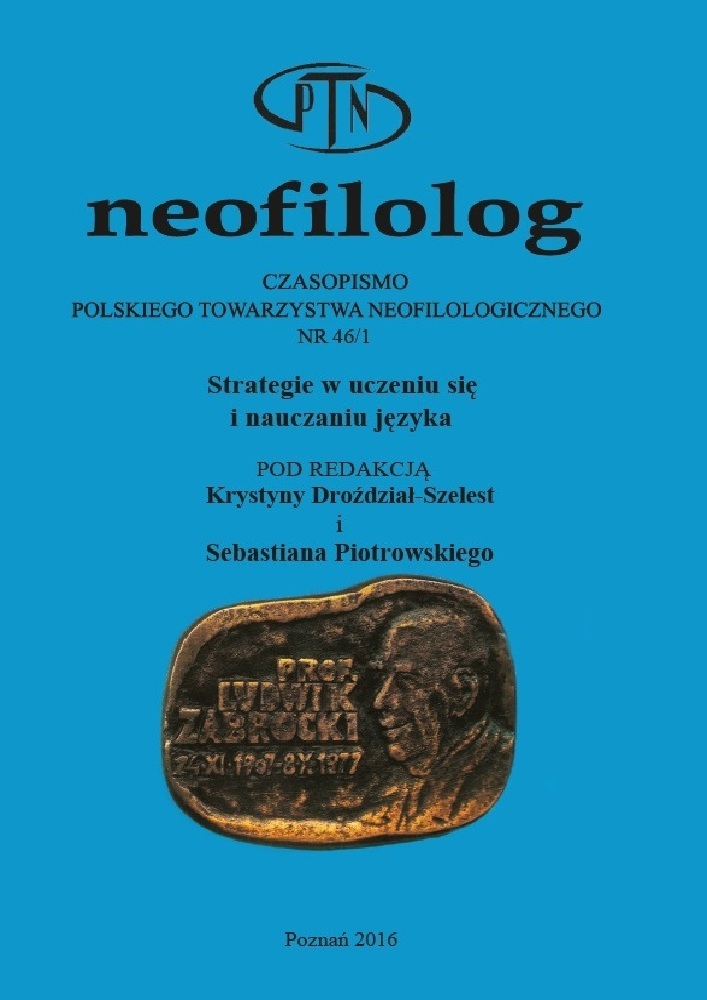Abstrakt
Although language learning strategies are a well-researched topic, there are still some aspects which need further investigation and one of these is the application of strategic devices in the second and third language. The following article seeks to compare how learners of two foreign languages use strategies and shows both differences and similarities between the application of strategic devices by presenting the results of a research project in which a questionnaire and an interview were used as the research tools. Strategies were found to be used more often when learning the L2 than during the process of learning the L3. Dissimilarities were observed in the specific types of strategies used, especially in the case of metacognitive strategies, while similarities were noted in the use of affective strategies.
Bibliografia
Cohen, A.D. i Chi, J.C. 2002. “Language strategy use inventory and index”. (w) Maximiz-ing Study Abroad (red. Paige, R.M., Cohen, A.D., Kappler, B., Chi, J.C. i Lassegard, J.P.). Minneapolis: Center for Advanced Research for Language Acquisition, Uni-versity of Minnesota: 16-28.
Cohen, A. D. 2014. Strategies in Learning and Using a Second Language. Abingdon: Routlege.
Dörnyei, Z. i Shekan, P. 2003: “Individual differences in second language learning” (w) The Handbook of Second Language Acquisition. (red. Doughty, C. i Long, M.). Oxford: Blackwell: 589-630.
Dörnyei, Z. 2005. The Psychology of the Language Learner: Individual Differences in Second Language Acquisition. Mahwah, New York: Lawrence Erlbaum.
Dörnyei, Z. 2007. Research Methods in Applied Linguistics. Oxford: Oxford University Press.
Ellis, R. 2004. “Individual differences in second language learning” (w) The Handbook of Applied Linguistics (red. Davies, A. i Elder, C.). Oxford: Blackwell: 525–551.
Gi-Pyo, P. 2011. “The validation process of the SILL: a confirmatory factor analysis”. English Language Teaching 4: 21-27.
Griffiths, C. 2008. “Strategies and good language learners” (w) Lessons form Good Language Learners (red. Griffiths, C.). Cambridge: Cambridge University Press: 83-98.
Griffiths, C. i Oxford, R. 2014. “The twenty-first century landscape of language learning strategies: introduction to this special issue”. System 43: 1-10.
Korkmaz, Ş.Ç. 2013. “Third language learning strategies of ELT learners studying either German or French”. Hacettepe Ȕniversitesi Eḡitim Fakültesi Dergisi Journal of Education 28: 92-104.
Mißler, B. 2000. “Previous experience of foreign language learning and its contribution to the development of learning strategies” (w) Tertiär – und Drittsprachen: Pro-jekte und empirische Untersuchungen (red. Dentler, S., Hufeisen, B. i Lindemann, B.). Tübingen: Stauffenburg: 7-22.
Naiman, N., Fröhlich, M., Stern, H.H. i Todesco, A. (1995). The Good Language Learner. Clevedon: Multilingual Matters.
O’Malley, J. i Chamot, A. 1990. Learning Strategies in Second Language Acquisition. Cambridge: Cambridge University Press.
Oxford, R. 1990. Language Learning Strategies: What Every Teacher Should Know. Boston: Heinle & Heinle.
Oxford, R. 1999. “Learning strategies”. (w) Concise Encyclopedia of Educational Lin-guistics (red. Spolsky, B.). Oxford: Elsevier: 518-522.
Oxford, R. 2003. “Language learning styles and strategies: an overview”. Learning Styles & Strategies/ Oxford, GALA: 1-25.
Pawlak, M. 2011. “Research into language learning strategies: Taking stock and looking ahead” (w) Individual Learner Differences in SLA (red. Arabski, J. i Wojtaszak, A.). Clevedon: Multilingual Matters: 17-37.
Purpura, J. 1999. Learner Strategy Use and Performance on Language Tests: A Struc-tural Equation Modeling Approach. Cambridge: Cambridge University Press.
Rose, H. 2012. “Language learning strategy research: Where do we go from here?”. Studies in Self-Access Learning Journal 3: 137-148.
Rubin, J. 1975. “What the ‘Good Language Learner’ can teach us”. TESOL Quarterly 9: 41-51.
Stern, H. 1975. “What can we learn from the good language learner?”. Canadian Mod-ern Language Review 31: 304-318.
Weinstein, C. i Mayer, R. 1986. “The teaching of learning strategies” (w) Handbook of Research on Teaching (red. Wittrock, M.C.). New York: Macmillan: 315-327.
Licencja
Prawa autorskie (c) 2018 Zuzanna Kiermasz

Utwór dostępny jest na licencji Creative Commons Uznanie autorstwa – Bez utworów zależnych 4.0 Międzynarodowe.
Przedstawiany utwór (artykuł) upubliczniany jest na podstawie umowy z autorem i na licencji Creative Commons Attribution-NoDerivatives 4.0 International (CC BY-ND 4.0).
Użytkownicy mają obowiązek podania wraz z rozpowszechnionym utworem, informacji o autorstwie, tytule, źródle (odnośniki do oryginalnego utworu, DOI) oraz samej licencji;
- bez tworzenia utworów zależnych,
- utwór musi być zachowany w oryginalnej postaci.
Uniwersytet im. Adama Mickiewicza w Poznaniu zachowuje prawo do czasopisma jako całości (układ, forma graficzna, tytuł, projekt okładki, logo itp.).
